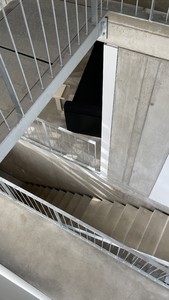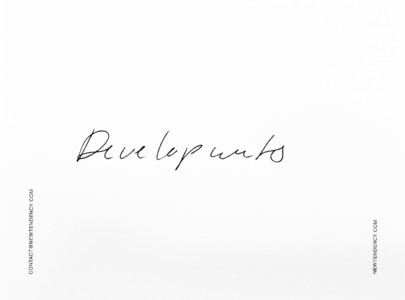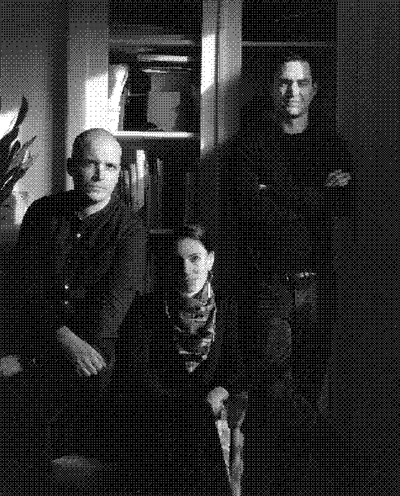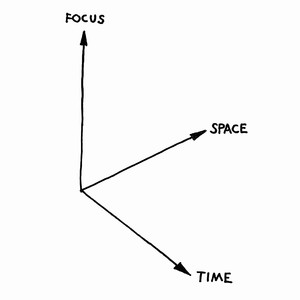Hi, Manuel, could you please introduce yourself?
My name is Manuel Goller. I’m the co-founder and creative director of New Tendency, a design and
furniture brand based in Berlin.


New Tendency co-founders Manuel and Christoph
How do you present your current activities?
We have two branches. One is New Tendency, the furniture collection, which is the most visible.
We typically present it on our website, in exhibitions, fairs, and on social media. The second branch, which we call New Tendency+, is more invisible. With New Tendency+, we do commissioned work and collaborations with brands, architects, and artists.
What’s your current state of mind?
I’m actually quite happy. It’s getting pretty chilly here in Berlin, but the sun is still shining.
I really like the transitional phases of the year; spring or autumn, when everything starts to change.


Could you tell us what got you into design?
I’ve always been fascinated by design, even before I could identify it as “design.” Ever since I can remember, I’ve been drawn to objects and spaces. What interested me was the influence they had on your life, both in the process of creation and in living with them. The physical result wasn’t necessarily what mattered; it was what they manifested as in the lives of the creator and the user.
I grew up in a very small village where after school, the doors would open and we were free to explore nature. In that environment, there were plenty of things to build and discover. As kids, we would create these elaborate ideas and construct them; like forts, treehouses… For me, that’s what design is all about: envisioning something and building it. And while building it, learning something. I think that if you do this well, the knowledge can transfer to the user. Living with an object derived from care and learning influences how you live for the better.


Did you study design or start as an autodidact?
From a young age I knew that I wanted to attend design school. I went to visit one early on, but they sent me away saying that I had to graduate first. So, I graduated from school, got a job, and later went to study at the Bauhaus University in Weimar in a very interdisciplinary program.
Were your inspirations in design already the Bauhaus and Modernism when you were studying?
The Bauhaus was obviously very present in Weimar because it’s the city where it was founded by Walter Gropius and others. I wouldn’t say, though, that this was my only source of inspiration. What interested me in the Bauhaus was not necessarily the visual language they developed but the collaborative infrastructure that Walter Gropius orchestrated so well. Keep in mind that Weimar is in the middle of nowhere in Germany. It’s a really small town, but Gropius was able to bring together all these very inspiring international artists, designers, painters, and musicians. There were sparks and something great happened. This dynamic has always been what inspired me most about the Bauhaus.
It still felt a bit like that in Weimar when I was there; it’s still a very small city and there are still students coming from all over the world. It’s exactly because of this that it works. It’s so small, and so you connect very easily with others. There’s not much else to do there; it’s quite natural to meet and start projects.


What did you do between school and founding New Tendency?
It’s a pretty seamless story: I co-founded New Tendency—back then we had a different name—with my friends while studying at Weimar. It was a project we did as students; nothing that we had planned properly or prepared a business plan for. It was more about coming together and trying to create a platform to provide visibility for our work. We started to organize exhibitions, first in Weimar and Leipzig, and then in Milan. People began to take notice and it developed into a company very organically.


When you were doing this project as a student and when you graduated, what did you think your career would be like?
It was not really about a career, and it’s actually still not about that or making money. It was just about doing something that’s fun; that has a purpose for those involved and hopefully for many others. We wanted to stick to it and work on it, really deliberately and consciously. Once we had some recognition, people started to show interest in the furniture pieces. We only had prototypes at the shows so we needed to work out how we could produce them. We started to think about how to package and communicate them, how to photograph them and provide context for them.
It was a very organic development, not oriented toward commercial success. We are still learning today. I have a lot of respect for long-standing, founder-led brands because it’s definitely an undertaking. Of course, in some departments you learn quickly, but in others the learning curve is very steep.


You talked about design and the Bauhaus. What were your other creative references and inspirations, even outside of design?
The primary inspiration for me personally and for the brand, apart from architecture, is art. I was quite lucky to move to Berlin after Weimar. Back in the day Berlin had—and still has—a very vibrant art scene with exhibitions happening constantly. It was really accessible: you could go see the work and interact with the artists.
At the time, I also worked for a design studio that catered to galleries and artists. This has all influenced us significantly, thanks to the artistic approach, the rigorous research that drives an artist, and the exceedingly high standards of quality in everything published or released.
Then there’s the craft involved. Even if it looks simple, most of the time there’s a lot of practice and training involved. These high standards, regarding the work on an intellectual and a craft level, are genuinely inspiring. And the impact this has on an audience—it’s an incredible thing to go to a museum or gallery and stand in front of an object that speaks to you on an emotional level or makes you think. That’s something I love and would like to accomplish with the products in our collection.


Would you say that your exposure to art has made your creativity and design evolve?
It’s hard to say, but I think personally I’m inspired a great deal by art, and I like the idea that this also reflects into our own work. As to whether that’s evident or not, that’s for others to decide. There’s a very technical side to design concerned with improving functionality or manufacturing, and we are also very interested in that and see it as a major source of inspiration. But I really like the more emotional and intellectual level of design, which plays a huge role in one’s perception of a work.


Sketch by New Tendency
How do you maintain the consistency and style of New Tendency?
It started out as a broad collection. Initially we had a variety of products and materials involved but we started to focus on specific materials. We didn’t want to do everything on a mediocre level, but rather to become experts on one material.
It was a pragmatic decision to reduce the collection to products that only consist of steel or aluminum—we just wanted to understand metal better. One or two years ago, we also started to work with wood. But only recently, after the years that we’ve spent understanding metal so well, have we felt confident enough to get into wood.
In general, we are very careful with the collection and rarely launch new products. It’s about responsibility to the market. We want to build products that last a very long time and create what we call “companions for life”—objects that travel with you through your entire life. If we add a new material to the collection, it’s because it is a very nice material that has good attributes. Wood is very strong and resilient, similar to steel, but it also has a certain warmth to it. That’s one of the main reasons we felt it would be a good addition to the metal products we are producing. Now, we have to get into wood and learn to use it better; really see what we can do with it. It will be a couple more years until we add another material.


You mentioned that you built the brand very organically, but it also seems there’s a very strong vision above and beyond the design itself. Along the way, did you have strategic references, brands, or designers in mind?
Of course. There are a lot of brands that I follow and admire. Our vision of embracing simplicity to enhance the quality of life is influenced by many references, both contemporary and historical. This vision has developed into a character, shaped by all the people involved. And it’s this character that dictates what we do.
I read an interview with an artist recently, saying that what you don’t do is as equally important as what you do. People often focus on the decision, or the things they do, but rarely think about the things that they don’t do. That’s quite important. The things you refrain from, the paths rendered invisible, are equally essential as the things you pursue.


Talking about this character. Do you know who you’re talking to, who’s buying New Tendency? Do you have figures, or is this also very intuitive?
To be honest, we don’t have a crystal clear picture of our customers. It’s an interesting thing, because our business can be very indirect. I’m always fascinated, though, by how aligned the value system is and how clearly people see our intention through the products or exhibitions we create. It seems to me that there’s no need to explain it, because there’s this invisible code in the product that gets decoded by the viewer. In our design or development process, you could say that we encode the product with our value system based on our sources of inspiration and interests. It’s like a hidden language. Most of the time, when I have the opportunity to meet a customer, there’s nothing to explain. They already know our perspective because they have understood it from our work, which is super fascinating.
This isn’t to say that our designs are programmed in a certain way. What I mean is the openness that people see in our work. They can see our approach and find an opening, a projection surface for their own identity. It makes for uses of the furniture that are unexpected. That’s a beautiful thing; people make the work their own.


You sometimes do consulting or design work for brands. Did you decide this development strategy yourself?
Yes, we do. It came to us unplanned, but it also happened quite naturally. Some of our clients run businesses or work for brands. They might make a personal purchase and later find that they genuinely enjoy it, thinking, “Couldn’t we do something together with these guys?”
It’s a small part of our business, but it’s very enjoyable. It’s faster turnaround, and what I find most engaging is that you have the opportunity to dive into different environments, brands, and products.
At the core, we are designers in a design studio, and designers have this curiosity to explore and learn about new things. With New Tendency, the visible collection, we are very limited in the way we communicate, the materials we work with, and the products we develop. So, outside challenges can be a source of inspiration. If a client tells us, “I don’t know how to solve this, I need your help,” there are immediate problems to think about and the sparks start to fly. That can be quite fun.


Meta Slide Table - NEW TENDENCY + Études


Meta Slide Table - NEW TENDENCY + Études


Meta Slide Table - NEW TENDENCY + Études
Does it also influence how you consider New Tendency’s development?
When we work with clients, we often learn things that have applications to our own brand, but we also learn about the wider context; the ever-evolving needs of businesses and society. I think the more intersections we experience, the better we can translate these learnings back into both our collection, and our work for clients.
Have you ever been approached by investors? What’s your view on this?
We have been approached by investors quite a few times but we have not yet decided to embark on a partnership. We are very passionate about the project and want to protect it, but we are open to conversations, because it would be beneficial for the brand and open more possibilities. What would be very interesting for us would be a strategic investor; not just someone who brings in money, but also knowledge and resources to push the brand further. This could be distribution, production, sales…


You talked about your small team. How many people are working at the moment around New Tendency?
We have a rather small team at our studio, but we also work with a remote network of collaborators. In general, I like working in a small team. Back in 2018 or 2019, we had more people in-house. I found that in a bigger team, it gets harder to get together behind a shared idea, and organisational topics can take up more space. I strongly believe that discussion and friction are productive, but when the group is rather big, things get lost in translation.
Of course, if you have more power as a team, you can work on more things in parallel. If you find a way to communicate your ideas, value system, and demand for quality in a way that’s accessible for everyone, then it’s easier to build a bigger team. I have not worked out how to do that yet but think it’s really a communication challenge. Every individual has their unique way of receiving information and communicating it. I think finding the key to communication for not only one, two or three people, but maybe five, ten, or fifteen––that’s a real talent; a real skill.
We first saw one of your design pieces with Services Généraux, the Meta Side Table. It was around 2018-19. You then gathered quite a niche, nearly cultish, following. Was that organic as well?
It’s like we talked about earlier: what we put into the project somehow gets decoded by the audience, and those are the people we attract. You can’t really control that, it’s what your input does reflexively. It’s nothing that you can influence along the way other than being as stringent as possible about your own design decisions.
But once it’s there, you surely want to maintain it. So you need to make communication or image decisions that go along.
Yes and no. People, interests, and audiences change. You can’t stop change. We don’t really want to maintain a certain audience; we will continue to do what we think is relevant and work on the things that we are curious about. Of course, we hope that people will follow us along the way.


New Tendency - Möbel, Spassky Fischer, 2024
That’s part of Fischli and Weiss’ manifesto: “Accept change as inevitable.”
It’s so true, especially in recent years. When we started the company, I thought that was a challenging time, but with what’s happened in the past three years… It’s mind-blowing. You really can’t plan for that. You just have to accept it, react to it, and continue with what you do in the best way possible.
Talking about communication, there’s very little incarnation of the studio. I imagine it’s a conscious decision.
It definitely is, and it was the case when we named the brand. With New Tendency, we always wanted to create something that many others could identify with, something that others could make their own. We wanted to let the brand and the products do the talking. You asked earlier about brands that inspire me: I’ve always appreciated Martin Margiela. It’s a brand that has a certain mystery around it and really puts product, concept, and idea––not necessarily people––out front.
You’ve been doing the full art direction—product photography, visual identity…
My approach is mainly about bringing talented people together, and inject guidance when needed. We don’t tell our collaborators what to do. It’s about inviting the people to the platform we have created, and allowing them to do what they do best. Of course, sometimes there are briefings when we need something specific for communication. In these cases there are more technical requests. Sometimes there’s also a conversation about the concept, but usually we leave it open to the creatives.
We worked early on with Jonas Lindstroem, who’s based in Paris now. He’s a very sought-after photographer now, but when we met in Berlin we were both just starting out. We gave Jonas the space to do the work he wanted to do, and talked about it a bit. It was the perfect fit in the end. It came together very nicely because we didn’t impose a direction. We gave him creative freedom, and that revealed a new perspective on our work that we couldn’t have expected.
How do you see the next steps in terms of communication?
We would like to reach more people. We are pretty niche, although often during new encounters, I get the feeling that many people resonate positively with what we are trying to express. I think the values we represent are quite universal and relevant to the moment, and I would like to reach a bigger audience with these ideas.


How do you think you could improve it?
I don’t have a clear answer, but I think the direction is more towards building strategies for creating relationships, which result in a network of people that are involved with New Tendency through exhibitions, interviews, or through work on communications, like photos or texts. I think it would fit within our value system better than digital advertising, for example, which often requires an unsustainable rate of scale and capital.
What do you think of the current design scene?
I would say that it’s quite vibrant. There are a lot of young companies and designers emerging, gaining more and more visibility. A good example is Kaleidoscope’s Capsule magazine, which is such a great project. There are a lot of traditional companies in the industry, companies that are 100 or even 200 years old and do amazing work. But I really like that a more contemporary, younger movement is pushing the market forward. This momentum is exhilarating, and I sometimes have to remind myself that a conceptual approach, and finding your own niche is more important than ever in this dynamic. It’s not always easy to resist riding the wave, but I’m convinced that keeping standards high and working on designs with a principle is what most brings the industry forward.


There’s also a strong sustainability issue.
Sustainability is a big concern for us, and over the years we have found how we can best align it with our approach. We think of it as three columns for responsibility. One is to try to produce objects that are timeless and designed in a way that allows them to be easily integrated into different environments over time. “Companions for life,” as I mentioned earlier.
The second column is materiality. We try to use resilient materials and produce them with an enduring quality. Of course, producing and processing steel is a very energy-intensive process, but it’s important to remember that these materials are practically unbreakable, and the object performs its function even when it has scratches and bumps (I love it when an object develops a patina over time). You can divide the energy input by the years an object is in use, and, if it is designed and built well, it nets out in the end. This is what we are aiming for.
The third column is how we communicate, or the narratives we build. The market has an urge to push news and product releases, especially if you refer to fashion. We try to meet this urge by creating new narratives around existing products instead of releasing new products all the time.
We invite artists, architects, and designers of different disciplines. The interesting thing about it is that not only does our audience receive a new perspective on the product, but we do as well. It’s a way for us to react to trends or experiences with new visual languages, without necessarily changing the product or releasing something new.


A few trivial questions now. If you had to do another job at another time in history, what would it be and when?
I would definitely like to have a job that somehow involves handcraft or building. What I’m not quite keen on in my day-to-day life is that I have to sit in front of a computer a great deal, so it would probably be a job where I can work with my hands, away from technology. Maybe being a carpenter, painter, sculptor, or landscape architect—something that takes me outdoors. Though it would probably have to be before computers or smartphones were invented, because I get too excited about the possibilities of new technologies.
The last question: what’s your advice for creative talents?
The most important advice I have is to stick to it; to not stop. Be persistent and keep going. That’s the most important thing. Don’t stop even if it becomes difficult or you don’t know where to go, this will all resolve. You just have to stay on it.


Sketch by New tendency



